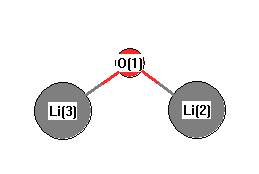Vibrational Frequencies calculated at B2PLYP=FULL/aug-cc-pVDZ
| Mode Number |
Symmetry |
Frequency
(cm-1) |
Scaled Frequency
(cm-1) |
IR Intensities
(km mol-1) |
Raman Act
(Å4/u) |
Dep P |
Dep U |
|---|
| 1 |
Σg |
785 |
755 |
0.00 |
|
|
|
| 2 |
Σu |
1036 |
997 |
330.78 |
|
|
|
| 3 |
Πu |
161 |
154 |
198.04 |
|
|
|
| 3 |
Πu |
161 |
154 |
198.05 |
|
|
|
Unscaled Zero Point Vibrational Energy (zpe) 1071.3 cm
-1
Scaled (by 0.9618) Zero Point Vibrational Energy (zpe) 1030.4 cm
-1
See section
III.C.1 List or set vibrational scaling factors
to change the scale factors used here.
See section
III.C.2
Calculate a vibrational scaling factor for a given set of molecules
to determine the least squares best scaling factor.
